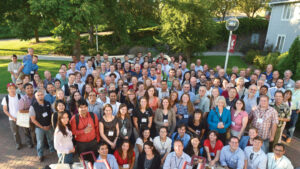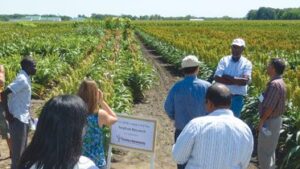July 9, 2014
NAPB Offers Platform for Plant Breeders to Communicate Needs
A book by Wes Jackson of The Land Institute inspired the career path of Seth Murray, a Texas A&M University assistant professor in the Department of Crops and Soil Sciences.
“I read his book about breeding perennial polycultures in high school,” Murray says. “If you look at the way plants occur in nature, there’s hardly ever bare soil. And with modern agriculture, that’s not the case. This has consequences in both productivity and ecosystem health but there has been little investment in breeding plants to fill this gap.”
Murray’s long-term career goal is to develop corn varieties that are sustainable and economical for farmers — specifically in areas that companies aren’t willing to take on because of the high-risk, long-term nature.
As a graduate student, Murray first got involved in the National Association of Plant Breeders in 2008 and volunteered to serve as secretary of the Harmony between Agriculture and the Environment subcommittee.
“NAPB is one of the best platforms to communicate the goals, needs and complexities of plant breeding,” Murray says. “Through NAPB, we’ve been able to showcase to policymakers and those outside of the industry that the success of plant breeders has allowed farmers to use 1/8 the land to produce the same amount of food. Now that land can be used to grow more food and create wildlife habitat.”
Murray also took on the role as web editor for the NAPB website, purchasing the domain names and migrating all the content over. “That’s been a real ground-level position,” he says. “I’ve been able to learn a lot and felt like I’ve been able to make a difference.”
Just last year, NAPB recognized Murray for his contributions within the industry and to the association with its 2013 Early Career Award at the annual meeting.
This year’s meeting will be Aug. 5-8 in Minneapolis, Minn., at the Minneapolis Airport Marriott and will focus on breeding for tolerance to water stress.
“In general, this is one of the best meetings for someone who is involved in either applied or molecular plant breeding,” Murray says. “Plus, there’s a great deal of graduate student involvement and it’s fun to see new and fresh energy coming into the field of plant breeding.
“It’s great for networking and strengthening connections. I’ve been able to meet a lot of leaders in plant breeding across many different crop species. The sky is the limit for people who want to get involved and contribute.”
For more information about the NAPB meeting, visit www.plantbreeding.org. Registration is $450 for members and $150 for students. To register for the 2014 meeting, visit www.plantbreeding.com












